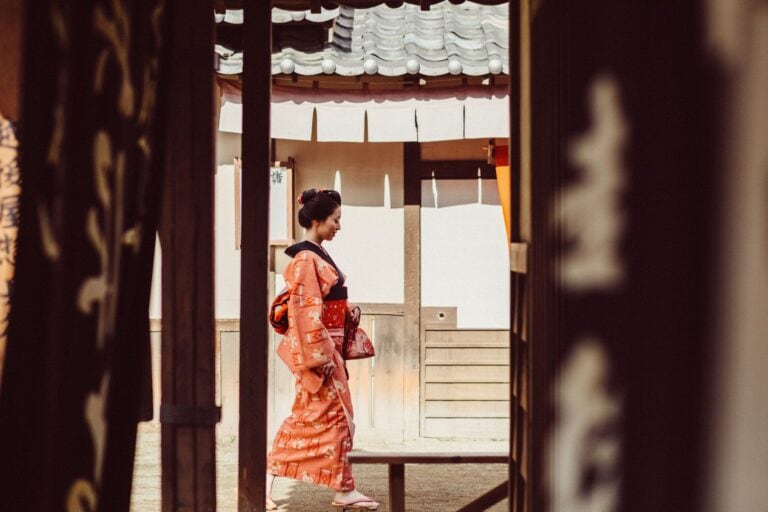
Her voice sounded melodic, soft and soothing. She glided across the tatami mats, dancing traditional steps that she had performed thousands of times. Her apprentice, fresh with youth and wearing a face of innocence and a colorful kimono, plucked the three-stringed shamisen instrument. We looked on with fascination as we enjoyed the rare opportunity of learning about the life, skills, and challenges of the modern-day geisha.
Understanding the Geisha
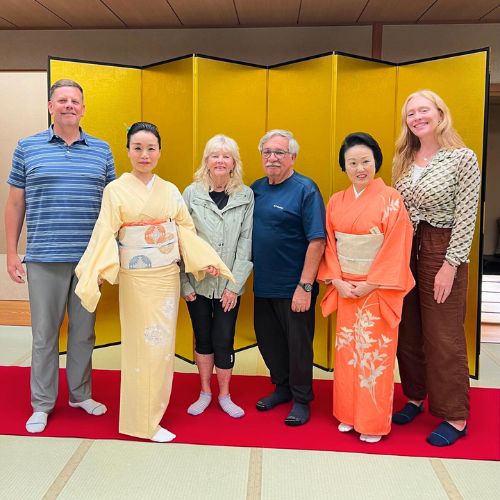
This iconic symbol that represents Japanese culture elicits, perhaps, the most misunderstood concepts of any profession exclusive to Japan. No counterpart exists in any other world society to these elegant, sophisticated women whose sole purpose is to provide costly, private entertainment through the hospitality mediums of musical instruments, dance, tea ceremonies, and conversation.
The mere mention of the word ‘geisha’ conjures up a universal image: beautiful, mysterious women who give the aura of human, porcelain dolls. White powdered faces devoid of noticeable flaws glow from tinges of rosy cheeks.
Stark black makeup around the eyes and brows provides a striking contrast. Deep red lipstick applied to the lower lip of trainees signifies purity or both lip layers for the older, more experienced geisha adds a punch of color. Shimada style wigs, silk kimonos, obi sashes, and red-strapped Okobo sandals create the likeness of graceful, Japanese idols.
Read More: 20 Japanese Customs Every Visitor to Japan Should Know
A Brief History of Geisha
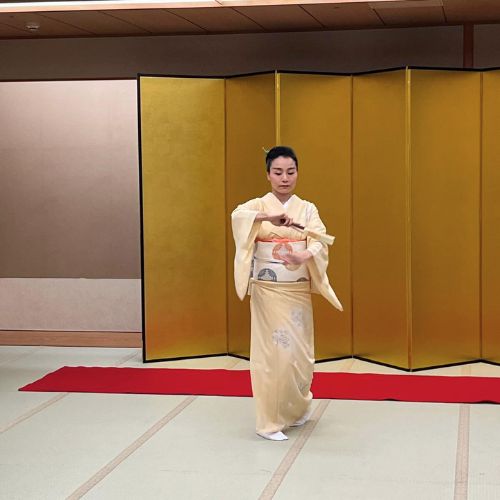
The history of geisha tradition in Japan, too complex and detailed to unravel here, dates back to the 17th century when women took over the role. In the 1920s, 80,000 trained geisha provided entertainment, but today, due to dwindling demand, that number has tumbled to just over 1000.
There are five regions in Japan where geisha customs still live on: Tokyo, Hakone, Kanazawa, Kyoto, and Osaka. Every hanamachi, the districts within each city where the geisha live in communal lodges or okiya, and work in teahouses called ochaya, operate with different rules.
Kyoto, the birthplace of the geisha tradition, has enacted laws to protect these women from the surge of fascinated tourists flooding the geisha district of Gion. Posted signs restrict taking any photos of experienced geisha, called geiko or young apprentices called maiko. There is a regulation in all districts that prohibits intrusion or any physical or sexual contact with the geisha during or after the entertainment of song, dance, and serving drinks or tea.
Experiencing Geisha Traditions in Hakone
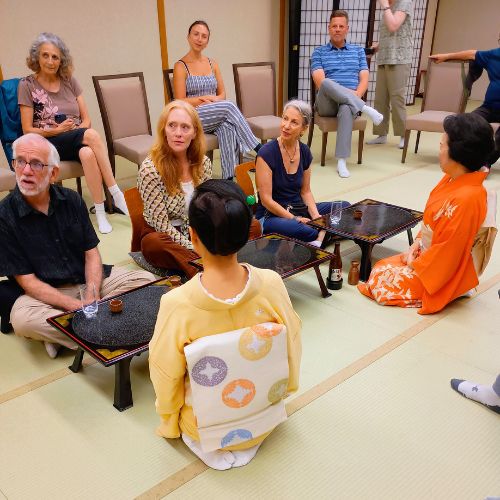
In Kyoto and the other provinces, interaction with geisha by foreign tourists is rare if not impossible. Clients who reserve time for personal attention from geisha at the local ochaya are carefully screened and are usually referred by regular customers. About 70% of patrons are CEOs of Japanese companies.
Fortunately, the hanamachi in Hakone, the mountain hot spring resort town outside of Tokyo, has taken a different approach to the survival of the geisha tradition. Located within the Fuji Hakone Izu National Park, the Hakone Yumoto Geisha Association, consisting of 120 geishas, created a program that has made Hakone one of the most popular tourist destinations in Japan. Here, the public can meet, experience, and learn about the challenges facing the modern-day geisha through organized public events and special presentations for individuals or groups.
It was within this context that our small cluster of Overseas Adventure Travelers had the opportunity to spend a captivating afternoon with a retired geisha, now acting as a madam, or ‘mother’, teaching the young girls in apprenticeship and a young woman who had recently achieved the level of professional geisha.
They answered our curious questions through our guide as interpreter, demonstrated a traditional tea ceremony, played musical instruments, and showed us the customary moves of ancient dance.
The Legacy of Anzu Matsuyoshi
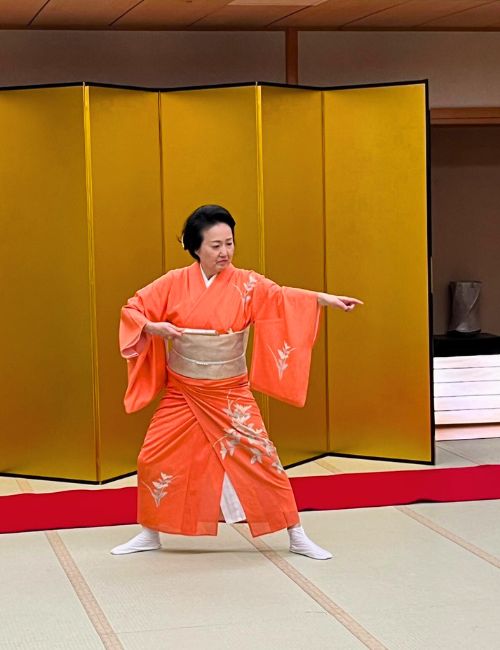
Meeting Anzu Matsuyoshi, who remains an icon in the geisha community here, was an honor. As a professional geisha in Hakone for 38 years, she now trains young women and attempts to correct any misconceptions about geisha tradition through interviews and international videos.
She related her unique story: “As a young girl working in an office in Gunma, Japan, I wanted to see other parts of the country. An ad in a magazine offered the prospect of a hospitality job, which included housing, salary, benefit package and retirement fund and it was located in the beautiful Hakone Mountains near Mt. Fuji.
I was very fortunate to be accepted into this wonderful organization of women, and I have devoted my life to this tradition. Only in Hakone do geisha belong to a union; the Geisha Arts Association takes care of all our needs and each woman is afforded a retirement pension.”
Read More: 10 Interesting Yet Unknown Facts about Japan and Japanese Culture
Training and the Art of Conversation
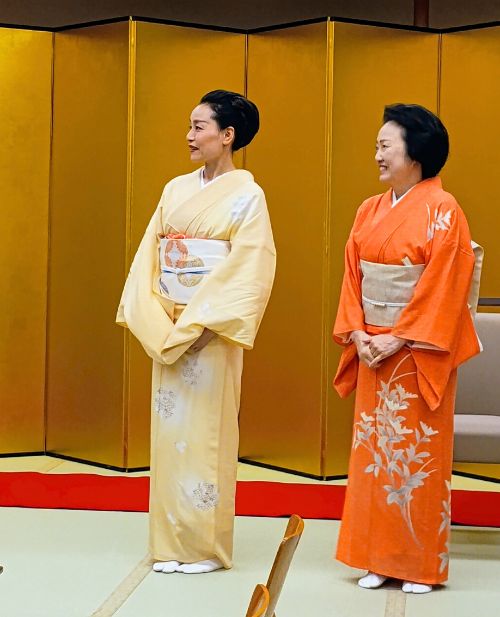
Anzu explained that girls as young as 14 are accepted for training, which lasts for a period from 2 to 6 years. They must live in an okiya under the guidance of the headmaster or ‘mother’ and must learn the art of song, dance, and playing Japanese musical instruments such as the Koto and shamisen.
Some clients often frequent the services of their favorite geisha for a familiar, sympathetic ear to their problems and anxieties. Anzu related that the art of conversation, listening, and consoling the client can become a major part of the experience.
In general, geisha provide an atmosphere of pleasurable entertainment: games, song, music, dance, conversation, and beverage services, but taking on the role of therapist remains a required skill.
Kyoto Gion Geisha District Walking Tour – The Stories of Geisha
The Grace and Challenges of Being a Geisha
As I watched them perform and personally interact with members of our group, I couldn’t take my eyes or ears from their soft-spoken, gentle words, their smoothly flowing gestures and graceful movement, and their constant facial expression of wanting to please.
I couldn’t imagine them ever raising their voices, saying negative words, or making awkward motions. I couldn’t fathom being able to be this controlled. Geisha, I learned, have an incredibly difficult job: to interrupt the rigors of everyday life and replace them with the pleasures of refined hospitality.
Inspire your next adventure with our articles below:
Author Bio: After a life-long profession of treating the mentally ill at a PA psychiatric hospital for 33 years, Carol retired to Lake Chapala, Mexico in 2006 with her husband, to pursue more positive passions. Her family thought that she too had ‘gone mad.’
Carol has taught English to Mexican adults and disadvantaged local children for the past 18 years. She writes for local, international, on-line and print publications. Using her adventures to over 120 countries, she has captured a niche in travel writing, and her stories have been featured in Go World Travel Magazine. A frequent contributor to El Ojo del Lago, the largest distribution English magazine in Mexico, she’s won several literary awards from that publication. Her psychiatric field work netted a contribution to the anthology, Tales from the Couch. Recently she has also been featured in two more anthologies, _Insider’s Guide to the Best of Mexican Holidays, and Bravados, Life, Love and Living in Lake Chapala, Mexico, all available on amazon.com.
Want to discover more hidden gems and helpful travel tips? Join our free newsletter for the latest travel secrets and travel articles.
We are reader-supported and may earn a commission on purchases made through links in this article.

